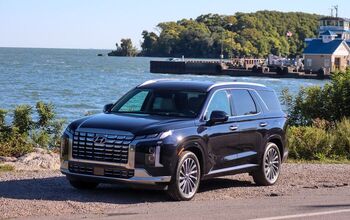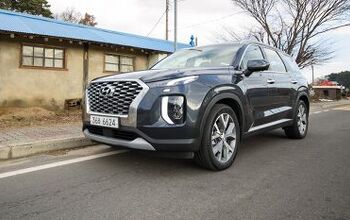2026 Hyundai Palisade First Drive Review: The New Standard

The 2026 Hyundai Palisade has just made my job harder—and easier.
It’s a well-worn auto journalist trope that most of us love minivans, almost as much as we love suggesting them to would-be buyers. It’s typically pretty easy: folks want a three-row family vehicle, and what else offers the level of real-world usefulness?
The new Hyundai Palisade comes close, delivering a spacious three-row package with one of the swankiest, best-appointed cabins you’ll find in the mainstream market. And in many other ways, it beats the ol’ standbys, by offering better tech and a soothing drive more often found in premium models. After a day getting to know the new flagship against the backdrop of the Palisade mountain range—yes, really—early signs point to another home run from Hyundai.
2026 Hyundai Palisade Quick Take
Hyundai continues its march upmarket with the 2026 Palisade, bringing new levels of comfort and style to one of the best three-row SUVs on the market.
What’s New for 2026:
Bigger in every dimension, the Palisade really pulls co-captain duty alongside the all-electric Ioniq 9, as both three-row SUVs share length (199.2 inches / 5,060 millimeters) and width (78.0 in / 1,980 mm). The Palisade is fractionally taller than its sibling, and its 116.9-inch (2,970-mm) wheelbase is roughly half a foot shorter. In other words, it’s big, landing firmly in the middle of the pack.
Beyond the natural new-model changes to styling inside and out, Palisade 2.0 will now offer twice the available powertrain options: a 3.5-liter V6 and a hybrid 2.5-liter turbocharged four-cylinder. When opting for the former, buyers will also be able to access the new XRT Pro trim, a rough-and-tumble model boasting more ground clearance (and the accompanying improvements to approach and departure angles), all-terrain tires, and unique styling tweaks.
Exterior Style:
Hyundai has a knack for dramatic redesigns, and the second-generation Palisade certainly qualifies. Up front, there’s a certain similarity to the outgoing model with a heavy use of patterns and repeating shapes, but that’s where it ends. The ’26 Palisade uses Hyundai’s light-up metal trim trick, first pioneered on the 2020 Sonata, to give the impression of an LED light signature at all times—and a blocky, angular one at that. Light-up bits in the grille offer a mercifully different take on the full-width illumination trend.
Move around the Palisade and the tweaks to the proportions are clearer, with a shorter front overhang shifting the visual weight rearward. There’s more than a hint of Range Rover to the gently tapered tail, what with the contrasting rear pillar and C-shaped taillights. Hey, there is a lot worse company to keep than the original luxury SUV. The top-shelf Calligraphy (Ultimate Calligraphy in Canada) rolls on big 21-inch alloys, which only reinforces the connection.
Swinging the other direction, the XRT Pro swaps in a more pronounced front grille, integrated tow hooks, and unique 18-inch alloy wheels wrapped in all-terrain rubber.
2026 Hyundai Palisade: All the Details
Powertrain and Fuel Economy:
While the big news for this Palisade generation is the (overdue) addition of a hybrid powertrain, that’s not what we sampled here. Hyundai will be staggering the powerplant roll-out, with the first few months being dedicated to the other new powertrain, the 3.5-liter V6. Slightly smaller than the six-pot it replaces, the new V6 posts nearly the same figures as before. Peak power sits at 287 horsepower (four fewer ponies than the ’25), while torque drops two pound-feet to 260. Fuel economy is essentially unchanged too, though emissions are down. Once again an eight-speed automatic handles shifting duties, sending power to the front wheels by default in America. All-wheel drive is optional in the US except on the XRT Pro, where it is standard. Canada once again skips the front-drive models as well, going all-in on AWD.
The new powertrain does the job, the V6 providing smooth, predictable power. While there’s a certain easy familiarity with a naturally aspirated V6, it does require revs where a turbo engine would not. Asking more of the V6 means relying on Hyundai’s in-house eight-speed, which is reluctant to kick down. Mash the pedal and there’s a noticeable second delay before the power arrives.
I cannot wait to drive the hybrid, as it should address the Palisade’s continued weakest aspect: an only okay powertrain. Not only does the electrified model boost power (329 hp and 339 lb-ft of torque), but with the targeted 34 mpg combined, it will offer comfortably better fuel economy than the (more powerful) Toyota Grand Highlander Hybrid Max.
Handling and Drivability:
On the road, the Palisade drives as expected: a big, comfort-first slice of family vehicle. There’s minimal feedback from the steering wheel because this isn’t that sort of vehicle. Nonetheless the steering is consistent in its weighting, so it quickly becomes easy to place the Palisade even on some of the narrower roads criss-crossing Napa Valley. It always drives “big” but never cumbersome.
Hyundai set up a short off-road trail to give the XRT Pro a chance to shine. Its taller tires and better off-roading angles get it through the obstacles without issue. Wheel articulation is unsurprisingly limited in this unibody vehicle, but set to the appropriate driving mode, the XRT Pro still sure-footedly crawls forward even with only three—or briefly, two—contact patches on terra firma. The only blemish on the report card is one example of the transmission slipping, though it was on the back end of a hot day after two previous drive waves.
Ride Quality and Comfort:
Thicker glass and more sound deadening make the Palisade positively serene on the highway. Block the badge on the steering wheel and you’d be forgiven for thinking this is a Genesis, such is the refinement. Even on the big 21-inch alloys, the Calligraphy ably handles big bumps, transmitting little motion or noise into the cabin.
Front seat comfort is some of the best in the class, at least based on this initial drive. Under-thigh support is good, and there’s enough squish to the cushion without getting that sinking feeling. There’s a wide range of adjustment as well, easily accommodating my drive partner and I.
The second row is one of the most spacious in the class, offering a full 43.0 inches (1,092 mm) of legroom and 40.7 inches (1,033 mm) of headroom. Lower trims come with a bench as standard, while most everything else swaps in captain’s chairs. Calligraphy buyers will find Hyundai’s Relaxation Seat in the first two rows as well. The third row is power-operated, with around six inches of fore-aft adjustment: it can also be folded flat at the touch of a button in the cargo area, though the power folding is quite slow. Accessing the third row is made easier with a one-touch solution on the middle row seats, providing an opening almost three feet wide while also allowing a baby seat to remain in place.
Interior Style and Quality:
I’m not going to mince words here: the ’26 Palisade is the new class leader for cabin design. With plenty of curves, overlapping surfaces, and smart texture selection, there’s a timeless sort of mid-century lounge feel to the interior, especially for the Calligraphy trim. We lucked out with the caramel Nappa leather of our tester, which looks swanky and feels it, too. The overlapping design of the center console not only looks good, but contains lots of useful storage space as well as 100 watts (combined) of USB charging. The leading edge also doubles as a palm rest for accessing the climate controls; smart ergonomic design, that.
While not visible in the mid-day shots here, the indirect ambient lighting peeking out from the concave dashboard design is also ace: far classier than the disco steampunk vibe of a certain German luxury brand, for instance…
Hyundai also hasn’t shied away from physical controls, which should be commended. I’m still getting used to that odd electronic shifter position, but putting the start-stop button directly on it helps. Tucked right behind that is a smart pairing of toggle and button to handle all the different drive and terrain modes: tap the button above, and then toggle from below. Easy peasy.
Tech and Safety:
Hyundai has kept things relatively simple with the primary tech suite of the Palisade. There’s nothing new here, all familiar bits working together for a positive experience. Take the curved twin-screen display for instance: it runs Hyundai’s ccNC infotainment, which is easy to use and offers speedy wireless Android Auto and Apple CarPlay pairing.
The usual smattering of Hyundai tech is all present and accounted for here, including the Blind View Monitor—which shows up nice and early on the trim walk, too—and the great full-range adaptive cruise control.
New for the Palisade is an integrated dashcam, which records both interior and exterior angles and stores it to an (upgradeable) memory card. The system can also record various vehicle parameters like speed and location. Having the system integrated right into the touchscreen is a huge boon for usability.
Value, Dollars, and Sense:
2026 Palisade pricing in America kicks off at $40,430 including destination for a front-drive Palisade SE. The XRT Pro sits roughly mid-pack, ringing in at $50,865, while the Calligraphy AWD rocks up at $57,555.
Canada’s trim walk is much smaller than America’s, with just five total across gas and hybrid powertrains. The family starts with the $55,799 CAD Palisade Preferred Trend, the XRT Pro slides in just under $60,000 CAD, and Ultimate Calligraphy rings up at $64,599 CAD.
While prices are up across the board, they still fall below multiple other choices in the segment—choices that aren’t as refined or as feature-heavy. Conveniently, the Calligraphy also lands right between the last (hybrid) minivans we tested, the Kia Carnival and Toyota Sienna.
Final Thoughts: 2026 Hyundai Palisade First Drive Review
It’s not often that a vehicle wraps up a generation as the best in its class, especially on its first time up at bat, but that’s exactly what the original Palisade is doing: going out on top. It won our last three-row mega comparison, after all. So it’s a big deal that the new model effectively improves on every aspect save the powertrain, where it at least holds steady (until the hybrid arrives). Exceptionally finished inside and out, with plenty of space, tech, and good road manners, the 2026 Hyundai Palisade looks poised to further pull prospective buyers from every other option in the class, and even many premium alternatives. And yes, also the minivans.
Become an AutoGuide insider. Get the latest from the automotive world first by subscribing to our newsletter here.

Kyle began his automotive obsession before he even started school, courtesy of a remote control Porsche and various LEGO sets. He later studied advertising and graphic design at Humber College, which led him to writing about cars (both real and digital). He is now a proud member of the Automobile Journalists Association of Canada (AJAC), where he was the Journalist of the Year runner-up for 2021.
More by Kyle Patrick










































Comments
Join the conversation
No mention of long term reliability concerns?
Dang,,, They stole the dashboard out of the new Mustang....!